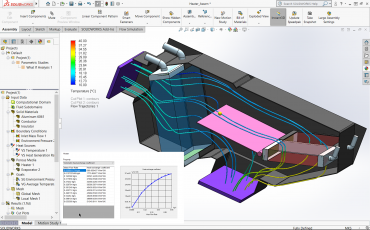


Automation tools for customization of standard workflows.E = EMOD1 + EMOD1T * (T - TSTAR) YIELD1 / YIELDT1: Yield stress.Model Preparation, Process, and Results Interpretation The material parameters are as follows: EMOD1 / EMODT1: Shear elastic modulus. Modeling drag effect of filtersġ3 Moving Obstacles Geometries can be defined as moving in the geometry interpretation dialog Object velocity is given as a function of time Useful for modeling pistons etcĬalculating Thermoelastic Stresses have been added Flow evaluation must be enabled for the elastic stress module Thermoelastic Stress model is enabled in Solver Parameter dialog When 'Flux surface' is enabled a history plot will be generated about the metal flow through the baffle. Measuring fluid flow through given location. Heat conductivities and heat emissivity coefficients can be given for all obstacles and the metal.ġ1 Baffles 1/2 Baffles are two dimensional elements that reside between calculation cells Void regions are typically used for modeling gas regions Void region type is defined with pointers Select 'Pick point' feature from the toolbar Click on a location on screen 'Picked Point' dialog will appear with the coordinates of the picked point Click 'Go to pointers.' to define the void type for the cavity in the picked locationįor each of these three void types a separate temperature and pressure s can be given. There is a possibility in Flow-3D to declare three different types of heat transfer voids. The values defined here are appended as they are to the prepin.inp file from where the solver reads the simulation problem definition Values given here have precedence over any values written by the Conifer Cast user interface The bottom of the dialog has fields for entering the variable name and its value. Left hand side contains a list of namelists as defined in the FLOW-3D prepin.inp specification Rght hand side contains a list of defined varibles and their current values. The user interface allows the user to enter the following values: Center of rotation (x, y and z) Axis of rotation (x, y or z) A table of angular velocities indexed by time (velocities in degress / second) In postprocessing the view is rotated according to given angle valuesĪ new feature for declaring Flow-3D input variables that are otherwise unsupported by Conifer Cast has been implemented. The whole simulation domain is rotated according to given timetable Effects on fluid inertia gravity direction This is used for simulating tilting casting system. ' The GMRES method can also be used for viscous stress evaluation, but only if it is used for pressure- velocity coupling.Ĥ Tilt Pour Casting 1/2 A new feature for specifying non-inertial reference frames.

This method is the generic minimum residual method (GMRES), which is a generalization of the conjugate gradient method for non- symmetric problems. New solver iteration method GMRES has been introduced. Numerical options contains options that control the technical details of the solver behavior. Presentation on theme: "Conifer Cast 2.5 New Features: Numerical Options"- Presentation transcript:ġ Conifer Cast 2.5 New Features: Numerical Options GMRES Iteration Option for Pressure- Velocity Coupling Tilt Pour Casting Custom Flow-3D Parameters Three Heat Transfer Void Types Baffle Setup Moving Obstacle Setup The Thermoelastic Stress Model Implicit Surface Tension Air Entrainment ModelĢ Numeric Options A new dialog 'Numerical options' have been introduced.


 0 kommentar(er)
0 kommentar(er)
